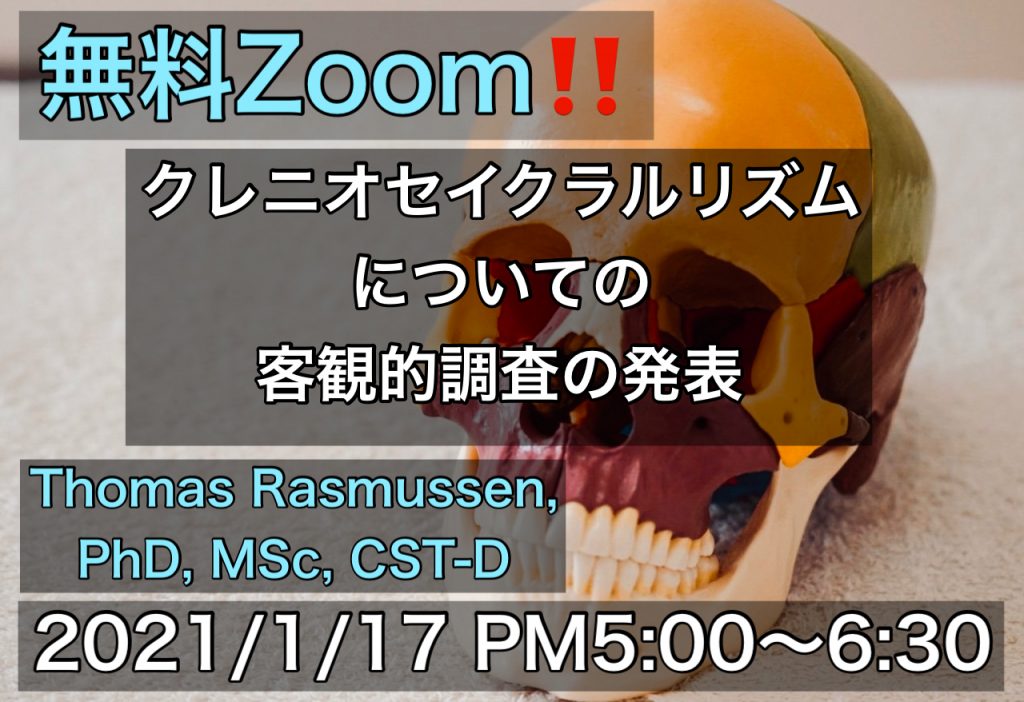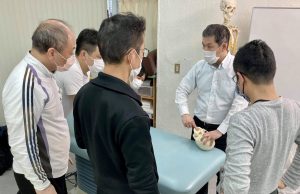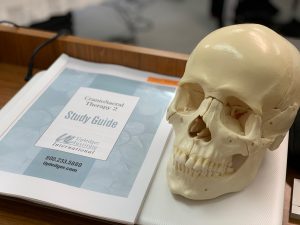【無料Zoom】クレニオセイクラルリズムの客観的調査の発表

長年議論の的となっていた脳脊髄液の動き、クレニオセイクラルリズムについて、デンマークのThomas博士が機器を用いて計測した結果が先日雑誌にて発表されました。これに基づき、Thomas博士をお迎えしてZoomにて無料ライブを行います。
いわゆる「静止点」は実際に存在するのか?など見どころたくさん!疑問質問にもお答えいたします!
2021年1月17日(日) PM5時〜6時30分
【講師】Thomas Rasmussen, PhD, MSc, CST-D
【通訳】平塚佳輝、佐藤鉄也
まず下記のURLから入っていただき、氏名(ローマ字)、メールアドレスの登録をお願いいたします。
https://us02web.zoom.us/meeting/register/tZMrcOCrqj8iE9VeeYYqTjuG01WSrl4LbWkd
すぐに返信メールが届きますので、1月17日PM5時開始に合わせて”Click Here to Join”を押して、ご入場ください。
【お願い!】
返信メールから入手したリンクはシェアしないよう、お願いいたします🤲
申し込みやZoomの使い方など、日本語にてご質問がある方は、私本間からお答えいたします。
↓↓↓
inaina.oste@gmail.com
【内容】
Researcher Thomas Rasmussen, PhD, MSc, CST-D presents about his recent scientific paper that pertains to the craniosacral rhythm.
デンマークのThomas博士が、クレニオセイクラルリズムに関する最新の調査について語る。
A study exploring rhythmic oscillations of the human head was published in the Journal of Bodywork and Movement Therapies entitled Direct Measurement of the Rhythmic Motions of the Human Head Identifies a Third Rhythm by Thomas Rosenkilde Rasmussen and Karl Christian Meulengracht.
人の頭でのリズムの調査は「Journal of Bodywork and Movement Therapies」上で掲載され、タイトルは「Direct Measurement of the Rhythmic Motions of the Human Head Identifies a Third Rhythm by Thomas Rosenkilde Rasmussen and Karl Christian Meulengracht」となっている。
A central concept in CranioSacral Therapy, and at the same time controversial, is the concept of a unique rhythmic movement separate from arterial and respiratory rhythms. Palpation of the unique rhythm is central and used worldwide by a high number of therapists. A significant source of the criticism and controversy of both the existence and reported range of a unique rhythm in humans is the subjective approach to study rhythmic movements by palpation.
クレニオセイクラルセラピーの重要な概念として心臓脈や呼吸脈とも違うユニークなリズムがある。これは世界中の多くのセラピストによって使われているが、このリズムの疑念として、触診による主観的なアプローチであるということである。
The aim of the study was:
(1) to characterize the rhythmic movements on the head relating to the arterial, respiratory, and a possible third rhythm.
(2) to describe the nature of the third movement.
(3) to define the normative range of the third rhythm in humans using an objective method.
この調査の目的
1.頭蓋の動きとして心臓脈、呼吸脈、第3の脈のリズムを明らかにする
2.第3のリズムの特質をつかむ
3.客観的な方法を使って、第3のリズムの通常の幅を定義する
In humans, a third rhythm separate from arterial and respiratory rhythms was observed. The lecture will go in detail with the results of the study and its implications concerning CranioSacral Therapy are discussed.
今回心臓脈や呼吸脈とも違う第3のリズムが観察された。このセミナーではその調査の結果、そしてクレニオセイクラルセラピーで議論されている懸念に関して詳細が語られるだろう。
Download PDF of Research Paper:

